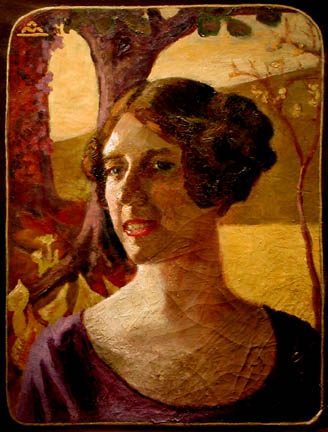At the center of Wilmington’s art scene lies the life and artwork of Elisabeth Augusta Chant (1865-1947). Chant served as a key figure in the development of the local artistic community during the early 20th century—making a lasting impact that persists to this day.

Image credit:
- Elizabeth Chant (American, b. England 1865-1947)
- Violet and Gold (Self Portrait), c. 1925
- Oil on canvas
- Collection of the Cameron Art Museum
- Gift of Mr. and Mrs. Henry B. Rehder
Caption
In this Self-portrait of Elisabeth Chant, Chant can be seen looking off into the distance and smiling. For the time period, it was very unusual to see a self-portrait where an artist bares their teeth in a smile. Chant has been documented by many patrons and students as being on the radical side of creativity.
But before Chant ever arrived in Wilmington, she was becoming an artistic giant in her own right. Her story begins in 1865 in Somerset, England, where she was born. She spent the first years of her life traveling with her parents on her father’s trade routes and claimed to have “sailed the seven seas by the age of seven”. Later, her family settled in Minneapolis, Minnesota, where her love of art flourished into the beginning of a career. While in Minneapolis, Chant’s family encouraged her to study nursing. She pursued that path. Becoming a professional nurse, but her passion for the arts could not be quelled. With the financial independence obtained through nursing, she dedicated herself to the pursuit of art, studying at the Minneapolis School of Fine Arts. In the late 19th Century, she opened an art studio with her friend and colleague, Margarethe Heisser. Together they acted as female pioneers in the Minneapolis art scene.
But her place of birth—the land of Arthurian legends—and her worldly upbringing continued to be major influences in her work. Chant was fascinated with the legends and stories of King Arthur’s Court—and even believed she could trace her own ancestry back to King Arthur himself.

Image credit:
- Elizabeth Chant (American, b. England 1865-1947)
- Guinevere (Single Lady in Garden), c. 1922-1930
- Watercolor on paper
- Collection of Cameron Art Museum
- Gift of Henry Jay MacMillan
Caption
In this painting, Chant depicts Guinevere, the wife of King Arthur, navigating through a stylized garden. The flowers in the foreground are abstracted in an otherworldly way, and the minimal color palette punctuated by punches of orange adds to the magical feel.
Chant’s interest in Arthurian legend grew further when she gained an interest in the occult and spiritualism. She felt that she could convene with spirits, including that of King Arthur himself. One of her journal entries states: “Painted King Arthur from life at 4 A.M.”
For her family, his discussion of speaking with spirits was cause for great concern. In 1917, while she was living in Massachusetts, they had her forcibly arrested and committed to a mental institution. After spending three years there, in which time she was isolated from her art and her creative community, she moved to Wilmington. At the age of 57, she started anew.
Chant had big aspirations for this coastal town, intending to start an artist colony. Although she did not form the colony as intended, she was an avid teacher. During her time in Wilmington, she fostered local talents such as Claude Howell and Henry Jay MacMillan—both of whom are featured in Cameron Art Museum’s Close to Home collection. Chant is considered the matriarch of Wilmington’s art scene not just because she taught local artists, but because her students went on to build Wilmington’s artistic community even more. For instance, Claude Howell was integral to the creation of the art department at UNCW. Henry MacMillan was a founding member of the Lower Cape Fear Historical Society.
Chant is even distantly responsible for the existence of Cameron Art Museum today. Two of her students, Hester Donelly and Margaret Tannerhill Hall, went on to manage St. John’s Art Museum—the Cameron before it was Cameron. Chant’s impact on the local art community is as undeniable as it evident everywhere one looks. Truly the artistic matriarch she is described as, Chant passed on revolutionary artistic techniques and inspired the creative minds of our area to pursue their own unique paths.
